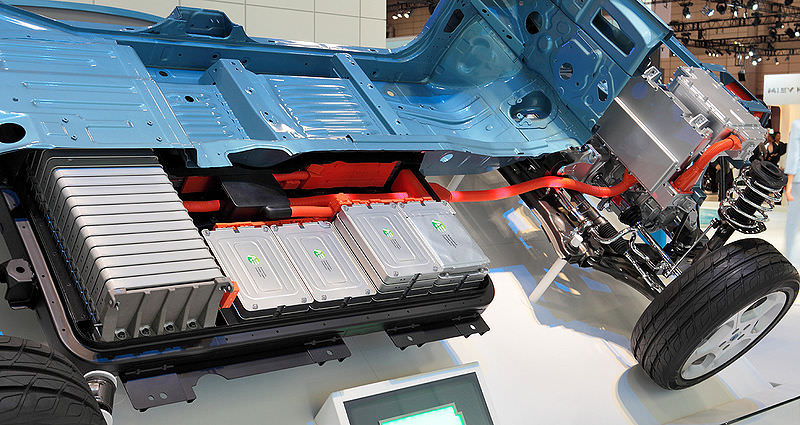 When Bjorn Lomborg wrote
When Bjorn Lomborg wrote
“Green
Cars Have a Dirty Little Secret” for The Wall Street
Journal earlier this month, he based his argument—that
electric vehicles (EVs) are no better for the environment than
internal combustion engine vehicles (ICEVs) due to the
manufacturing process—on
a 2012 study published by the Journal of Industrial Ecology
(JIE). He made a convincing case, and I must admit:
I was taken in.
But the convenience and even wide-spread belief of something
doesn’t necessarily make it true. Spurred on to seek out the truth
by a very helpful Reason reader, I took a hard look at the
JIE study from Hawkins et al.
I wasn’t the first to do this, but I hope to be one who cares
more about the facts than an agenda.
As it turns out, the JIE study that Lomborg points to contains a
number of problems that should raise a quizzical scientific
eyebrow. In fact, Hawkins et al. were forced to issue a
correction to their report in January.
In the JIE correction, EVs come out much greener than they do in
Lomborg’s op-ed. While Lomborg states that “unless the electric car
is driven a lot, it will never get ahead
environmentally,” Hawkins et al. come to a different
conclusion:
We find that EVs powered by the European electricity mix reduce
GWP [global warming potential] by 26% to 30% relative to gasoline
(originally 20% to 24%) and 17% to 21% relative to diesel
(originally 10% to 14%).
Even in the original study, EVs came out ahead over an estimated
lifespan of 90,000 miles, despite being loaded down with
lithium-ion batteries that scientific advancements have not yet
made kind to Mother Nature. Still, reducing emissions by up to 30%
without necessitating any changes to our current energy consumption
habits can hardly be called “never getting ahead.”
 And that’s assuming that
And that’s assuming that
Hawkins et al. have actually reached a reasonable conclusion now
that they have corrected their estimates of the required production
inputs for a Nissan Leaf—their representative EV for the study.
Instead of assuming, however, let’s take a look at another
study.
This UCLA report prepared for the California Air Resources
Board,
Lifecycle Analysis Comparison of a Battery Electric Vehicle and a
Conventional Gasoline Vehicle, compares EVs (which they refer
to as BEVs, or battery electric vehicles) to ICEVs (which they call
CVs, or conventional gasoline vehicles). On pages 18 and 19, the
authors report average expected CO2 emissions over a lifetime of
180,000 miles for an ICEV to be more than twice those
expected for an EV.
In sum: both the JIE and the UCLA studies reach very similar
conclusions. Hawkins et al. find EVs to be up to 30 percent cleaner
than ICEVs over 90,000 miles and the UCLA study estimates 64
percent lower CO2 emissions over 180,000. (Keep in mind: this is
with current battery technology as well as current energy mixes,
which rely primarily on fossil fuels.)
And yet Lomborg dismisses this still-fledgling technology as
doing “virtually nothing.” He’s right that EVs are not “zero
emissions,” of course. But if the chief goal of a buyer is to
reduce greenhouse gas emissions, they are a step in the right
direction.
That having said, a reduction in greenhouse gas emissions isn't
grounds for thousands of dollars in subsidies from Uncle Sam. Let
the market decide if it's worth driving an electric car to be
green, not the government.
UPDATE (3:00 pm): Bjorn Lomborg reached out to
me via email with this response that I think is worth posting:
I do know of the correction to the Hawkins study, but it
just changes the outcome about 6% (they're very explicit about it
not changing much). However, the US electricity grid is also
significantly more co2-intensive than the EU average, which was why
I kept their estimate of 24% less emissions if driven 90,000 miles
in my WSJ. It is not surprising, that if the car
is driven twice that at 180,000 miles, it will emit even
less.My point with the WSJ article, however, was also to point out
that if you can only drive 73 miles at a time (and likely much
less, both because you want to avoid being stranded, like NYTimes
reporter John Broder, and because the range declines to 55 miles in
five years), it is much less likely that you
will drive even 90,000 miles and certainly 180,000 miles before you
change your battery and hence increase your co2 emissions
again.Moreover, if you buy a car with a longer range (just drove a
fantastic Tesla with almost 300 miles range)—its batteries will
obviously have emitted so much more co2 in production that it is
unlikely the car will ever earn it back.So, I don't think these points serve to undermine my argument,
but rather simply show that the numbers are pretty clear. If you
drive little (50,000 miles or less), you'll emit more co2. If you
drive rather much (90,000 miles) you'll probably emit 76% of a
gasoline car (with average US electricity), and if you drive your
electric car exceptionally far (180,000 miles) you might just emit
half of a gasoline car.All that remains to think about is how far will most future
purchasers of a Nissan Leaf actually drive their car. Most will buy
it as their second car for short, infrequent trips.
This is an excellent point. In writing this post, I focused
solely on rebutting the idea that EVs can't make up for their
manufacture with lower greenhouse gas emissions over time (and
miles). I stand by what I've written above—they can even with
current technology. If you drive them long enough.
However, Lomborg's point that many will buy these as second cars
and use them only rarely and for short trips is probably very true.
If you're buying one of these cars to reduce your emissions, you
better actually drive it a lot (instead of your ICEV) and hold onto
it for as long as possible. Otherwise they're just a wasteful
fashion statement—like pretty much every other car on the road.







0 σχόλια:
Δημοσίευση σχολίου